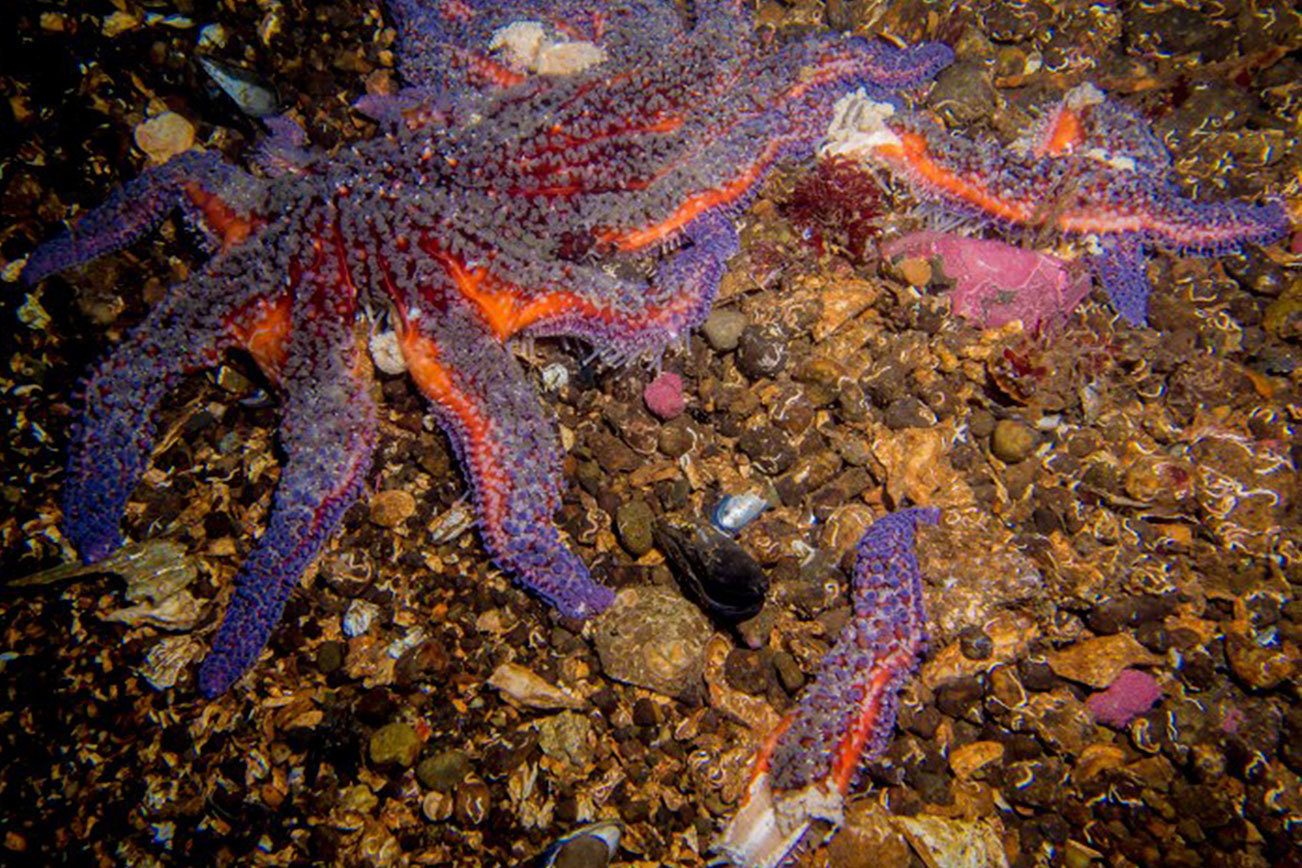by Bob Friel
Special to the Sounder
Science usually happens a millimeter at a time. When looking at an animal population, for example, changes in abundance are often revealed in the data as a slight trend line amid cyclical ups and downs. But then there’s what’s happened to our sunflower sea stars.
Sea Star Wasting Disease (SSWD) has taken its deadly toll on at least 20 species of echinoderms. First noticed here in the Salish Sea in 2013, this current epidemic has since devastated starfish from Mexico to Alaska. In our region—a world-renowned hotspot for sea star diversity—the virus affects blood stars, giant pinks, morning sun stars, the beloved ochre sea star, and many others. None, though, have been hit as hard as the sunflower sea star.
When over 8,000 citizen-scuba diver surveys collected by REEF (Reef Environmental Education Foundation) were graphed to show sunflower counts, it didn’t show a shallow descending trend line. It literally traced the path of a falling star.
The hope that deep waters below the divers’ range still held healthy populations that could act as a genetic reservoir was dashed when the Washington Department of Fish and Wildlife’s (WDFW) annual deepwater sampling trawls came up with similar results: the “near extirpation” of sunflower sea stars throughout the state’s inland waters.
The inescapable fact is that what was once the most commonly seen invertebrate in the Salish Sea has almost disappeared in just a few years.
Sunflowers are the magnificent beasts of the sea star world, with as many as 24 arms that from tip to tip can measure up to the size of a nine-year-old child. And they use those arms to chase down sea urchins as enthusiastically as a nine-year-old chasing down an ice cream truck on a hot summer day. Sunflower predation is such an important control on urchin populations (which left unchecked can raze kelp forests) that the sea stars are considered ecosystem engineers. Remove them from the picture and we’re likely facing a domino effect of negative outcomes for all kinds of plant and animal species. Evidence of such a “trophic cascade” is already being found by researchers in British Columbia.
SeaDoc and our partners at REEF, WDFW, Cornell University, Vancouver Aquarium, and the Seattle Aquarium, which brought together experts for an emergency scientific summit on SSWD a year ago, have been at ground zero of this epidemic from the start. And with such startlingly clear results from the science and such alarming potential for further damage to the ecosystem, we feel there’s no time to lose in moving forward quickly with sunflower sea star conservation.
Consequently, SeaDoc lead scientist Joe Gaydos, with help from multiple collaborators like REEF, WDFW, Cornell, SR3 Sealife Response, Rehabilitation and Research, and others, have submitted a proposal to NOAA National Marine Fisheries Service to list the sunflower sea star as a US Federal “species of concern.” This is NOAA’s proactive protection program, with the aim of evaluating threats and identifying research priorities for at-risk species in the hope they can be saved before having to be listed as threatened or endangered under the US Endangered Species Act.
The proposal for listing is currently being reviewed while SeaDoc and other scientists continue to try and understand the workings of sea star wasting disease, including studying how this massive marine disease outbreak will ultimately change the Salish Sea and other coastal marine ecosystems. Thanks to your support, SeaDoc is on the case.



